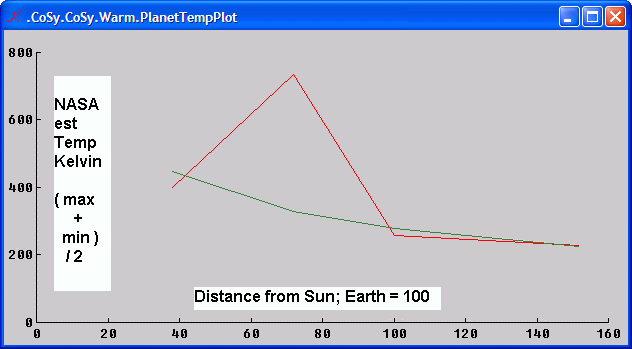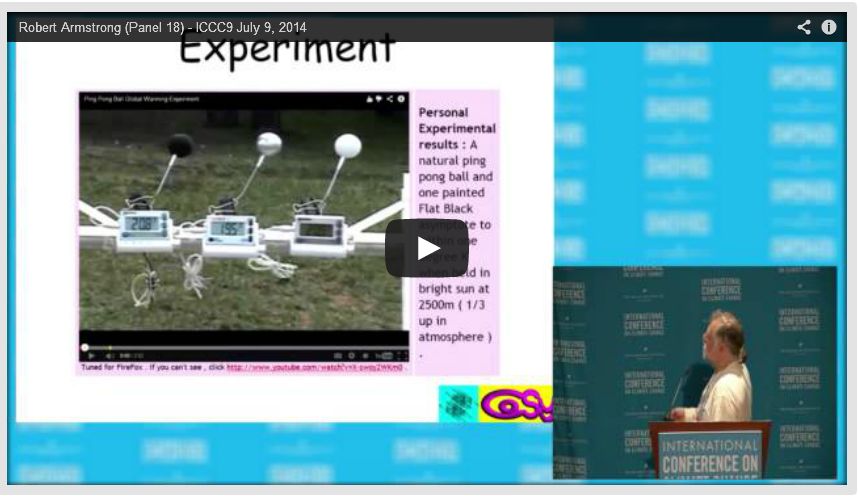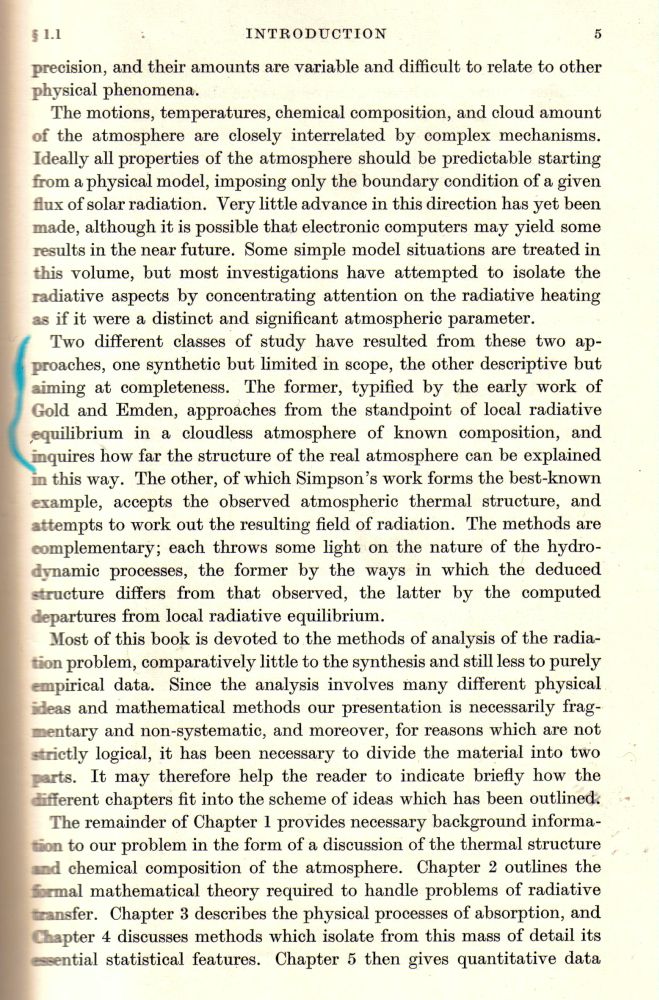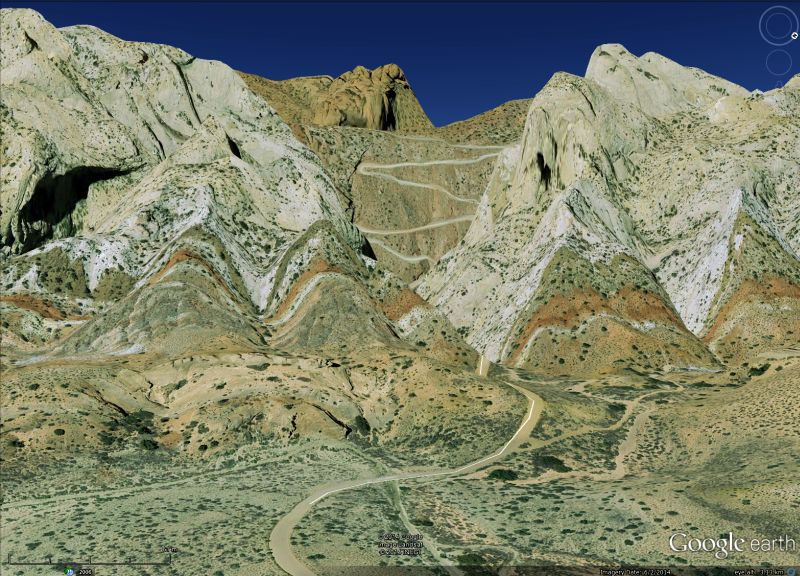|
Show me your equations
 Given such demonstrations of willful
ignorance by an urban crowd ( which
my observation of NYC events during my couple of decades
there and the images I've seen , I judge to be significantly less than 300k
) as we just witnessed , I'm far from sure there is any
way to inform the willfully stupid .
Given such demonstrations of willful
ignorance by an urban crowd ( which
my observation of NYC events during my couple of decades
there and the images I've seen , I judge to be significantly less than 300k
) as we just witnessed , I'm far from sure there is any
way to inform the willfully stupid .
#Need for an open online explication of the
basic physics of planetary temperature
I
have been diverted into the whole AlGoreWarming
( blame Stanley Goldenberg ;)
) statist stupidity only because I could not find a competent ,
quantitative analysis of the physics of planetary temperature anywhere
on the openly accessible web . What I saw and continue to see is
astoundingly mathematically and physically amateurish , and often just
plain wrong .
I come to the problem as someone who aced high-school physics thanks to the brilliant , but unforced , PSSC curriculum , but then followed other interests which eventually led to my living a life where array algebra was always at my fingertips . It is far easier , and never conclusive , to wave around words or even indulge in computational clouds not grounded in the most basic observations and theory than to quantitatively explain observations from the most precisely understood theory and data .
 I naturally started by implementing the most basic
relationships . At Joe Bast's invitation , I initiated an Essential
Physics page on Heartland's ClimateWiki . Even the inverse square-root
law implied by Stefan-Boltzmann for the temperature of a planet given
its distance from the sun and the fact that all the inner planets other
than Venus are within a few percent of their calculated values is a
high-school level fact I have never seen presented anywhere . It alone
rules out fantasies of "terraforming" Mars to bring it up to a livable
, ie , greater than 274k , temperature . ( As I noted in my
presentation , the variation in our orbital distance from perihelion (
in January ) to aphelion implies a difference of about 4.7c . Yet I
have never heard of a report finding this necessary effect ,
which is much larger than the total asserted warming , in the data . | 20150428 |: See Watts Up With That 2015/01/09 two-new-papers-suggest-solar-activity-is-a-climate-pacemaker/ )
I naturally started by implementing the most basic
relationships . At Joe Bast's invitation , I initiated an Essential
Physics page on Heartland's ClimateWiki . Even the inverse square-root
law implied by Stefan-Boltzmann for the temperature of a planet given
its distance from the sun and the fact that all the inner planets other
than Venus are within a few percent of their calculated values is a
high-school level fact I have never seen presented anywhere . It alone
rules out fantasies of "terraforming" Mars to bring it up to a livable
, ie , greater than 274k , temperature . ( As I noted in my
presentation , the variation in our orbital distance from perihelion (
in January ) to aphelion implies a difference of about 4.7c . Yet I
have never heard of a report finding this necessary effect ,
which is much larger than the total asserted warming , in the data . | 20150428 |: See Watts Up With That 2015/01/09 two-new-papers-suggest-solar-activity-is-a-climate-pacemaker/ )
I encourage you to review Essential Physics for any errors , and to submit the algorithms in more common languages , and flesh out the many stubs with the relevant explications and algorithms .
Finding no basic college level introduction ( comparable to those in other branches of applied physics ) on the web , it took me a , in retrospect , ridiculous amount of time to reduce the essential equation for radiative balance given a source power spectrum and an object absorptionemission spectrum to finding T such that :
where
dot : { +/ x * y } . or most mimimally , dot : +/ * in K .
This
is the equation which , given the crude hypothesis that the earth
absorbs 0.7 of incoming solar radiation , but emits as a black body ,
ie , 1.0 , produces the ubiquitous 33c atmospheric greenhouse effect
. I actually was surprised that when applied to Venus , it is
quantitatively impossible by an order of magnitude to explain its
surface temperature , 226% ( 2.26 times ) that of the gray body temperature in its
orbit , as a greenhouse effect .
This
meme , that Venus is the greenhouse the Earth may turn into ,
promulgated unchallenged for years by James Hansen , is accepted
without analysis by the general "climate science" community .
Recently in reply to a blog post I can't locate in which I made
the assertion above , Joe Bastardi expressed the common comment that
the extreme Venusian surface pressure was the answer . In other words ,
that pressure , per se , was a parameter left out of the equation above
. But it's not . Compressing a gas , of course increases its
temperature , but static pressure does not simply make something have a
higher equilibrium temperature . ff it did , we could solve our energy
problems simply by filling up scuba tanks which would stay hot and we
could stick a thermocouple in the middle of them and collect the
current from an identical one outside . More formally , the divergence theorem
says that the interior of an externally heated sphere will come to the
same mean temperature as that calculated for its surface . That is ,
the center cannot be hotter than the surface without some internal
source of heat .
 I
remember a brief chat with Willie Soon at the 2009 WDC conference in
which we disagreed on the value of experiment in addressing these
planetary issues . I think the above is an example where
experiment can be dispositive . Of course
these laws were abstracted from experiments more than a century ago
. And it was largely the brilliantly simple experiments in the
PSSC curriculum , despite my intense allergy to writing them up
and turning them in
, which contributed to my acing the College Board . Now
days small cryogenic vacuum chambers start around $1500 which is within
the budget of affluent high-schools . ( BTW : Thanks to whoever
chose that cover shot for my talk . Much more to the point than would
have occurred to me . )
I
remember a brief chat with Willie Soon at the 2009 WDC conference in
which we disagreed on the value of experiment in addressing these
planetary issues . I think the above is an example where
experiment can be dispositive . Of course
these laws were abstracted from experiments more than a century ago
. And it was largely the brilliantly simple experiments in the
PSSC curriculum , despite my intense allergy to writing them up
and turning them in
, which contributed to my acing the College Board . Now
days small cryogenic vacuum chambers start around $1500 which is within
the budget of affluent high-schools . ( BTW : Thanks to whoever
chose that cover shot for my talk . Much more to the point than would
have occurred to me . )
Why APL
My attack is as an APL programmer capable of expressing physics in
executable notation as
or more succinct than in any printed textbook . And that ability to
casually compute and "play with" the computations was the subject of
the first 2 slides of my Heartland
presentation
. A half century after Ken Iverson's original work , APL remains
as revolutionary as calculus was a half century after Newton and
Leibniz . A friend of mine , Brooke Allen , recently connected on
LinkedIn . His I owe EVERYTHING to
some funny symbols provides another perspective on APL's impact . Yet another slice at APL is the videos of the winners of this year's Dyalog APL competition .
I had an interesting brief chat with Roy Spencer the first evening of the Heartland conference . After expressing my thumbs up for his justification of the use of the the term climate nazis , I mentioned that my presentation would be on the most basic computations of radiative balance with all the algorithms used presented in APL in the slides . Roy mentioned they , like Gavin Schmidt , do everything in FORTRAN . He said he and his programmer had tried more "modern" languages , but always found limitations which drove them back to FORTRAN . We did find that we both spoke the same language of dot products and the like tho . ( I just tested that my nascent 4th.CoSy will do a dot product on a million floating points on my Intel 3470 based desktop in an imperceptible amount of time . ) I don't think the simple algorithms used to calculate the radiative balance for arbitrary spectra in my presentation get across the expressive power of APLs . A recent accounting example came up which better illustrates the abilities . This is in the legacy K from Kx.com which I used in my presentation and still use for all my accounting . I had a list of 8 expenses , call it Q . I wanted to figure out what subset of the matched a check I received . So I executed the following lines :
QW : &:' + 2 _vs ! _ 2 ^ 8 | make an array to select all the subsets
| of the 8 items .
QW @ ,/ & -442.92 = +/' Q @ QW | find the subset that adds up to 442.95
2 4 5 6 | The indices of the matching subset .
Q @ 2 4 5 6
-19.95 -37.39 -35.58 -350
To
explain a little : There are 2 ^ 8 , 256 , subsets of 8 items .
The ! _ 2 ^ 8 returns the first 256 integers ( the
first being 0 ) . The 2 _vs converts each
one to its binary string of 0s and 1s . The &:'
converts each of them to the indices of all the 1s . The second
line selects selects all of those subsets of the expense items , Q
, and adds each of them up . Then it tests which one equals -442.92 and
returns the row corresponding list of indices from QW .
So , I know that the check was for items 2 4 5 6
of my list of expenses .
Let
me see that in FORTRAN , even with a lot of array features influenced
by APL added over the decades . For that matter let me see that
procedure expressed as succinctly in any traditional mathematical
vocabulary , including Mathematica .
I
have Hollerith card boxes full of FORTRAN implementing a small sample
statistic for my masters in the mid '70s . Then the Vogelback
Computing Center got APL and I never had time for legacy languages again
. To me , their only use is implementing APL functionality . And
for that purpose , I see Forth
, whose philosophical goal is the the minimal vocabulary capable of
extending itself from the silicon up , as the only foundation of
interest .
|
Time out for a
commercial :
Of the 2 corporate systems I wrote after learning APL catalyzed my loss of tenure in grad school , the more significant was rewriting Xerox's long range world wide market forecasting system which I had been contracted to maintain . It took overnight to aggregate reports and cost a quarter-million a year in mainframe time . It had been written in APL by COBOL programmers . It happens one of the last courses I had sat in on was introductory topology where I had learned the binary representation of a relation . One weekend , since I had access to the mainframe from my apartment , I took a cross section of data and implemented the essential relational selection functions in terms of a boolean image of the data . I demonstrated that I could speed up retrievals and computations by a factor of about 3000 turning overnight requests into at worst a few minutes -- with concomitant savings in CPU costs . That sold them on having me rewrite the whole system , essentially creating a numerical relational database language capable of doing rapid , for the time , computations on up to about 14 million entries . I would like to make a similar offer to anybody who has a planetary physics related computational task which would require a week or two in FORTRAN or whatever to program . If I can't do it over night , I'll do it over a weekend . |
My
background gives me a pretty good understanding of spectra , but not
conduction much less convection . Convection doesn't come into
long term averages .
My
overall goal , a
planetary model in APL , specifically in , 4th.CoSy
, requires personal collaboration with real physicists who know
the essential algorithms and the data and how it is collected . I
don't even know how one accurately collects the ae spectrum of a
planet . Does it change from day to night ? Such a change
could easily account for our 3% over our orbital gray body temperature
. I actually implemented that sort of partition of
the sphere for grayvalues , ie , scalar ae
,
before taking on spectra . That partition vocabulary is the
foundation of any mapping of the sphere , eg , adding spectra and
cosine functions to each patch .
Beyond
being my own tool of
thought , my motivation for learning APL was to be able to read
papers such as this :
Astrophysical APL - Diamonds in the Sky , Schneider, Paluzzi, & Webb :
Members of the Space Telescope group present the physics of carbon white
dwarf stars in half a dozen short APL functions.
presented at the APL89 conference in NYC . I felt a population understanding an APL level notation was the only way my own work could be communicated .
In early September in a blog battle with a dedicated warmist , I was referred to a table of Venus's emission power spectrum David Crisp at JPL . I sent him messages thru JPL's website facility on Thursday , the 11th , and again on Wednesday , the 17 . These are posted in the Disqus section of my Basic Basics page . I followed up leaving him a voice mail , Friday , the 19th . He has not gotten back to me even with a few relevant URLs .
While this pursuit of a quantitative understanding of planetary temperature must , in the absence of support , fall back to being just a third order avocation , I have purchased a couple of old editions of books mentioned as classics on the Science of Doom warmist , but physics oriented , blog . SoD is kind of like a warmist WUWT but oriented more towards understanding the physics rather than the data .
Overall
, they've confirmed my disinclination to gamble textbook prices on
books which may or may not have a useful correlation with my particular
path .
Specifically
, I've gotten
-
Introduction to Heat Transfer , 2006 , Incropera, Frank P. et al
Has taught me more about the difference between engineering and physics . Slow on getting to the meat , but lots of interesting examples . Have learned one interesting observation :
" because [density] and [mean free path] are directly and inversely proportional to the gas pressure, respectively, the thermal conductivity is interdependent of pressure except in extreme cases as, for example, when conditions approach that of a perfect vacuum."This implies that the temperature gradient across Venus's atmosphere should be fairly linear .
Induced me to pull out an old Schaum's Outline of Theory and Problems of Heat Transfer , 1977 , Pitts & Sissom . to get straight to the formulae .
-
ATMOSPHERIC RADIATION , Theoretical Basis , 1964 Goody, R
Suffers from age , eg , the prominence of byzantine British measures , eg , the Rankine temperature scale .
Goody makes the interesting observation , quoted in the image on the right , that there are two approaches to understanding planetary temperatue , one starting from the measured phenomena and working to explain it . That appears to be the ubiquitous method . But without the other , the traditional analytical understanding of abstracted systems simple enough to be quantitatively confirmed by experiment , one never can be said to understand .
4th.CoSy
I ,
obviously , am focused on the second approach . Indeed , my superior
interest is the implementation of the executable computational notation
itself . That's actually a significantly more difficult problem . This
summer I failed to dissuade a guy out along Monterey Bay , CA ,
even with the image of a piece of my path out to the Heartland Las
Vegas conference , from attempting 4th.CoSy which spans the
spectrum from Intel X86 language thru Chuck Moore's minimal Forth up to
the ultimately abstracted notations inspired by Ken Iverson . He
convincingly has never programmed in any language .
So , I've been induced to upload a current version of
here : 4th.CoSy
Download & Disqusion .
|
If
you see my work as being useful to you in the largest sense , your support would be most helpful .
If you have any projects you would care to emphasize , let me know . |
|
 |
|

